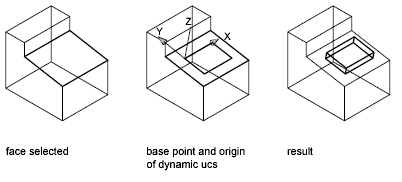With the dynamic UCS feature, you can temporarily and automatically align the XY plane of the UCS with a plane on a solid model while creating objects.
When in a draw command, you align the UCS by moving your pointer over an edge of a face rather than having to use the UCS command. After you finish the command, the UCS returns to its previous location and orientation.

 Show Me: Use Dynamic UCS
with Solid Models
Show Me: Use Dynamic UCS
with Solid ModelsFor example, you can use the dynamic UCS to create a rectangle on an angled face of a solid model as shown in the illustration.

In the illustration on the left, the UCS is not aligned with the angled face. Instead of relocating the UCS, you turn on the dynamic UCS on the status bar or by pressing F6.

When you move the pointer completely over an edge as shown in the middle illustration, the cursor changes to show the direction of the dynamic UCS axes. You can then create objects on the angled face easily as shown in the illustration on the right.
The X axis of the dynamic UCS is located along an edge of the face and the positive direction of the X axis always points toward the right half of the screen. Only the front faces of a solid are detected by the dynamic UCS.
The types of commands that can use a dynamic UCS include the following:
If Grid and Snap mode are turned on, they align temporarily to the dynamic UCS. The limits of the grid display are set automatically.
You can temporarily turn off the dynamic UCS by pressing F6 or SHIFT+Z while moving the pointer over a face.